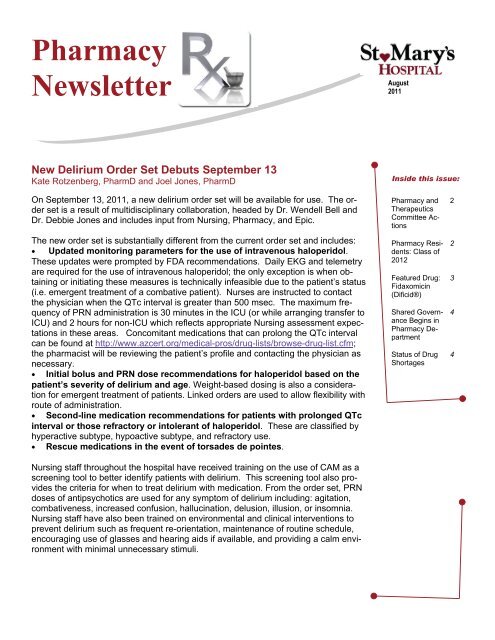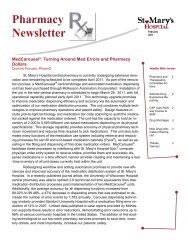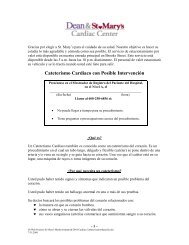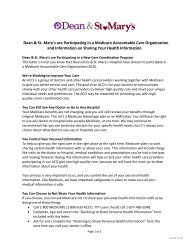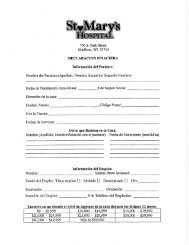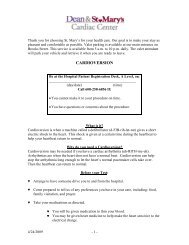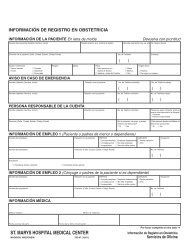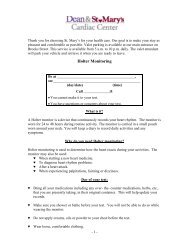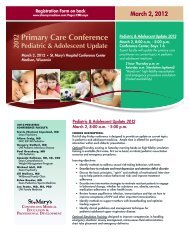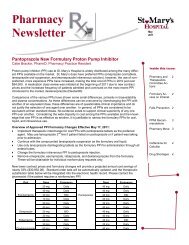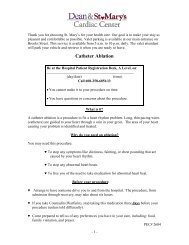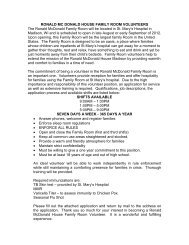Pharmacy Newsletter - St. Mary's Hospital
Pharmacy Newsletter - St. Mary's Hospital
Pharmacy Newsletter - St. Mary's Hospital
You also want an ePaper? Increase the reach of your titles
YUMPU automatically turns print PDFs into web optimized ePapers that Google loves.
<strong>Pharmacy</strong><br />
<strong>Newsletter</strong><br />
August<br />
2011<br />
New Delirium Order Set Debuts September 13<br />
Kate Rotzenberg, PharmD and Joel Jones, PharmD<br />
Inside this issue:<br />
On September 13, 2011, a new delirium order set will be available for use. The order<br />
set is a result of multidisciplinary collaboration, headed by Dr. Wendell Bell and<br />
Dr. Debbie Jones and includes input from Nursing, <strong>Pharmacy</strong>, and Epic.<br />
The new order set is substantially different from the current order set and includes:<br />
• Updated monitoring parameters for the use of intravenous haloperidol.<br />
These updates were prompted by FDA recommendations. Daily EKG and telemetry<br />
are required for the use of intravenous haloperidol; the only exception is when obtaining<br />
or initiating these measures is technically infeasible due to the patient’s status<br />
(i.e. emergent treatment of a combative patient). Nurses are instructed to contact<br />
the physician when the QTc interval is greater than 500 msec. The maximum frequency<br />
of PRN administration is 30 minutes in the ICU (or while arranging transfer to<br />
ICU) and 2 hours for non-ICU which reflects appropriate Nursing assessment expectations<br />
in these areas. Concomitant medications that can prolong the QTc interval<br />
can be found at http://www.azcert.org/medical-pros/drug-lists/browse-drug-list.cfm;<br />
the pharmacist will be reviewing the patient’s profile and contacting the physician as<br />
necessary.<br />
• Initial bolus and PRN dose recommendations for haloperidol based on the<br />
patient’s severity of delirium and age. Weight-based dosing is also a consideration<br />
for emergent treatment of patients. Linked orders are used to allow flexibility with<br />
route of administration.<br />
• Second-line medication recommendations for patients with prolonged QTc<br />
interval or those refractory or intolerant of haloperidol. These are classified by<br />
hyperactive subtype, hypoactive subtype, and refractory use.<br />
• Rescue medications in the event of torsades de pointes.<br />
Nursing staff throughout the hospital have received training on the use of CAM as a<br />
screening tool to better identify patients with delirium. This screening tool also provides<br />
the criteria for when to treat delirium with medication. From the order set, PRN<br />
doses of antipsychotics are used for any symptom of delirium including: agitation,<br />
combativeness, increased confusion, hallucination, delusion, illusion, or insomnia.<br />
Nursing staff have also been trained on environmental and clinical interventions to<br />
prevent delirium such as frequent re-orientation, maintenance of routine schedule,<br />
encouraging use of glasses and hearing aids if available, and providing a calm environment<br />
with minimal unnecessary stimuli.<br />
<strong>Pharmacy</strong> and<br />
Therapeutics<br />
Committee Actions<br />
<strong>Pharmacy</strong> Residents:<br />
Class of<br />
2012<br />
Featured Drug:<br />
Fidaxomicin<br />
(Dificid®)<br />
Shared Governance<br />
Begins in<br />
<strong>Pharmacy</strong> Department<br />
<strong>St</strong>atus of Drug<br />
Shortages<br />
2<br />
2<br />
3<br />
4<br />
4
<strong>Pharmacy</strong> and Therapeutics Committee Actions<br />
Kate Rotzenberg, PharmD<br />
From the May 25th meeting:<br />
Additions from Dean Formulary: none<br />
Additions to <strong>St</strong>. Mary’s Formulary:<br />
• The commercial preparation of hydroxyprogesterone<br />
caproate injection<br />
will not be added to formulary.<br />
Patients will continue to use their<br />
own supply compounded by local<br />
pharmacies.<br />
• C1 esterase inhibitor (Cinryze®)<br />
was added to formulary for treatment<br />
of acute attack of hereditary angioedema.<br />
MUE will be conducted in the<br />
future to ensure appropriate usage.<br />
Full monograph available on <strong>St</strong>.<br />
Mary’s Intranet.<br />
Drug Class Reviews<br />
• Nasal <strong>St</strong>eroids: Therapeutic Interchange<br />
approved to use fluticasone<br />
propionate for majority of patients<br />
and reserve budesonide for use by<br />
pregnant or potentially pregnant patients.<br />
Implementation date pending.<br />
Policy Changes<br />
• Argatroban, lepirudin, and magnesium<br />
(for OB only) have been added<br />
to the high-risk drug list requiring<br />
dual sign-off.<br />
• Updated Multi-dose and Single-dose<br />
injectable container Policy.<br />
From the July 27th meeting:<br />
Additions from Dean Formulary:<br />
• Lurasidone (Latuda®) - Tier 3<br />
• Dextromethorphan/quinidine<br />
(Nuedexta®) - Tier 2 with PA<br />
Additions to <strong>St</strong>. Mary’s Formulary:<br />
• Fidaxomicin (Dificid®) was added<br />
to formulary, restricted to use by<br />
Infectious Disease, for the treatment<br />
of C. difficile infection. MUE is<br />
planned in the future with focus on<br />
readmission rates. Full monograph<br />
available on <strong>St</strong>. Mary’s Intranet.<br />
Drug Class Reviews<br />
• Thiazide Diuretics: Therapeutic<br />
Interchange substituting chlorthalidone<br />
with hydrochlorothiazide was<br />
removed based on review of literature.<br />
Chlorthalidone 25 mg tablet<br />
added to formulary. Full review available<br />
on <strong>St</strong>. Mary’s Intranet and will<br />
be featured in next newsletter.<br />
Policy Changes<br />
• Updated Monitoring of Refrigerator<br />
Temperature Policy to reflect<br />
changes due to <strong>Pharmacy</strong> remodel.<br />
• Monitoring of Intravenous Haloperidol<br />
Policy reviewed, approval pending<br />
issue clarification.<br />
• Approved Palivizumab per <strong>Pharmacy</strong><br />
order for qualifying infants requiring<br />
long-term hospitalization.<br />
<strong>Pharmacy</strong> Residents: Class of 2012<br />
Kate Rotzenberg, PharmD<br />
If you see these smiling faces around<br />
the hospital, be sure to give them a<br />
warm welcome. Our new pharmacy<br />
residents, Jennifer Klink and Josh Rekoske,<br />
joined our department at the<br />
end of June and will soon be staffing<br />
weekends on CVICU and 5E in addition<br />
to their rotations throughout <strong>St</strong>. Mary’s.<br />
Jennifer is a 2011 graduate of Creighton<br />
University. She completed rotations<br />
in community outreach/visiting<br />
nurses and home health, drug information,<br />
critical care, acute care, ambulatory<br />
care, cardiology, and community<br />
pharmacy during her fourth year of<br />
pharmacy school. Jennifer is interested<br />
in working on improving documentation<br />
of pharmacist interventions<br />
and is excited to be working with our<br />
staff.<br />
Josh is a 2011 graduate of UW-<br />
Madison School of <strong>Pharmacy</strong>. During<br />
his fourth year of pharmacy school, he<br />
gained experience in<br />
solid organ transplant<br />
pharmacy, cardiac<br />
ICU pharmacy,<br />
pharmacy benefit<br />
manager Navitus,<br />
and community<br />
pharmacy. Josh had<br />
previously completed<br />
a third-year<br />
rotation at <strong>St</strong>. Mary’s<br />
working with Randy<br />
Binning in our Emergency<br />
Department.<br />
He is interested in<br />
researching pharmacy<br />
involvement in<br />
discharge counseling<br />
or medication education and potentially<br />
the effect of this intervention on<br />
readmission rates.<br />
Let’s not forget last year’s excellent<br />
resident class—Dominic Porcaro has<br />
stayed on at <strong>St</strong>. Mary’s as a staff pharmacist<br />
and Catie Brackin is a pharmacist<br />
at Advocate Lutheran General <strong>Hospital</strong><br />
in Chicago, IL. We wish them the<br />
best of luck as they move on in their<br />
pharmacy careers.<br />
Page 2<br />
<strong>Pharmacy</strong> <strong>Newsletter</strong>
Featured Drug: Fidaxomicin (Dificid®)<br />
Kate Rotzenberg, PharmD<br />
The full monograph that was presented to the <strong>Pharmacy</strong><br />
and Therapeutics Committee can be found on <strong>St</strong>. Mary’s<br />
Intranet under Policies and Procedures, <strong>Pharmacy</strong>, <strong>Pharmacy</strong><br />
& Therapeutics - Medication Summaries. Fidaxomicin<br />
is initially restricted to use by Infectious Disease due to its<br />
substantial cost. A medication use evaluation is planned<br />
for the future to determine appropriate usage and effect on<br />
readmission rates.<br />
Therapeutic Class/Indication: Macrolide antibiotic for<br />
treatment of Clostridium difficile infection<br />
Dosing: 200 mg by mouth twice daily for 10 days<br />
Administration and <strong>St</strong>orage: May be given with or without<br />
food. <strong>St</strong>ore at room temperature. Information on crushability<br />
is pending.<br />
Monitoring parameters: Clostridium difficile infection resolution<br />
(number of loose stools, abdominal cramping, etc),<br />
nausea/vomiting, rash<br />
Adverse effects/interactions/contraindicated: No significant<br />
drug interactions or contraindications. Do not use for<br />
systemic infection, minimal absorption. Information on<br />
cross-allergenicity is pending.<br />
Similar adverse effects as oral vancomycin in trials: nausea<br />
(11%), vomiting (7%), abdominal pain (6%), GI hemorrhage<br />
(4%), anemia (2%), neutropenia (2%). Adverse effects occurring<br />
in < 2% of patients: additional gastrointestinal disorders,<br />
increased alkaline phosphatase, decreased bicarbonate,<br />
increased hepatic enzymes, decreased platelets, hyperglycemia,<br />
metabolic acidosis, drug eruption, pruritis,<br />
rash.<br />
Pregnancy category/lactation: Category B. No information<br />
on lactation, use caution.<br />
Pharmacokinetics:<br />
• Absorption: Minimally absorbed, do not use for systemic<br />
infections.<br />
• Distribution: Confined to GI tract after oral administration.<br />
After 10 days of dosing, fecal concentrations of<br />
fidaxomicin and its metabolite are significantly higher<br />
than plasma concentrations.<br />
• Metabolism: Transformed by hydrolysis to main and<br />
microbiologically active metabolite, OP-1118. OP-1118<br />
is the predominant circulating compound at therapeutic<br />
doses.<br />
• Excretion: Mainly excreted in feces – more than 92%<br />
of single dose recovered in stool.<br />
Therapeutic efficacy:<br />
In a randomized, controlled trial including 629 patients,<br />
treatment with fidaxomicin resulted in equivalent cure rates<br />
compared to treatment with oral vancomycin in adult patients<br />
with mild-moderate Clostridium difficile infection.<br />
Patients treated with fidaxomicin had significantly lower<br />
recurrence rates compared to vancomycin, however there<br />
was no difference between treatments in recurrence rates<br />
for patients infected with the NAP1/027/BI strain (the<br />
“Quebec” strain, considered hypervirulent). Patients infected<br />
with any other strain of Clostridium difficile had significantly<br />
lower recurrence rates with fidaxomicin compared<br />
to vancomycin.<br />
Due to the improved recurrence rate, patients treated with<br />
fidaxomicin also had a significantly improved global cure<br />
rate compared to vancomycin (clinical cure and no recurrence<br />
within 28 days).<br />
There was no significant difference in time to resolution of<br />
diarrhea, although this was numerically shorter with fidaxomicin<br />
treatment compared to vancomycin.<br />
Comparative Cost of Therapy:<br />
Fidaxomicin:<br />
• $134.50 per dose = $2,689.96 per course of therapy<br />
Metronidazole:<br />
• 500 mg by mouth three times daily for 10 days<br />
• $0.04 per dose = $1.20 per course of therapy<br />
Vancomycin (FDA-approved for C. difficile-associated diarrhea):<br />
• 125 mg by mouth four times daily for 10 days<br />
• $1.69 per dose (using IV solution orally) = $67.60 per<br />
course of therapy<br />
Rifaximin “Chaser” (add-on therapy after completing course<br />
of metronidazole or vancomycin to prevent recurrence):<br />
• 400 mg by mouth twice daily for 14 days after standard<br />
therapy (alternative regimen is three times daily for 21<br />
days)<br />
• $15.22 per dose = $426.16 per course of therapy<br />
(twice daily for 14 days) in addition to standard therapy<br />
Nitazoxanide (nonformulary, FDA approved for giardiasis<br />
and cryptosporidiosis):<br />
• 500 mg by mouth twice daily for 10 days<br />
• $19.79 per dose = $395.80 per course of therapy<br />
Estimated admission charge for C. difficile infection at <strong>St</strong>.<br />
Page 3<br />
<strong>Pharmacy</strong> <strong>Newsletter</strong>
<strong>Pharmacy</strong><br />
Editor: Kate Rotzenberg, PharmD<br />
Drug Information Pharmacist<br />
Katherine_Rotzenberg@ssmhc.com<br />
700 S. Park <strong>St</strong>.<br />
Madison, WI 53715<br />
Phone: 608-258-6551<br />
Fax: 608-258-5626<br />
E<br />
Shared Governance Begins in <strong>Pharmacy</strong> Department<br />
Kate Rotzenberg, PharmD<br />
The <strong>Pharmacy</strong> Coordinating Council met for the first time last<br />
month to plan the roll out of the Councils: Operations; Patient<br />
Care; and Quality, Education and Safety. The Coordinating<br />
Council, consisting of the Chairs (right), Management, and Drug<br />
Information, discussed the need for a strategic plan and how<br />
the members of each Council should prepare for their roles over<br />
the next few months.<br />
The next steps will be to:<br />
• Develop SharePoint with Catherine Powers; this is the<br />
communication tool that will provide each member of the<br />
department a voice in decisions<br />
• Review preparatory materials (e.g. quality improvement<br />
measures, impact of health care reform, etc) to determine<br />
measurable goals for the department and inform the strategic<br />
plan<br />
• Begin developing a strategic plan with input from each<br />
Council<br />
<strong>Pharmacy</strong> WSSDM Councils:<br />
• Coordinating Council: Facilitate the integration of the<br />
other Councils, supporting the department’s strategic plan.<br />
Chair: Donna Kieler<br />
• Operations Council: Ensure the optimal use of human,<br />
fiscal, physical, and material resources based on the strategic<br />
plan, budget and best available evidence to support<br />
the delivery of exceptional health care. Chair: John Brown<br />
• Patient Care Council: Define and integrate a comprehensive<br />
approach to exceptional health care services across<br />
the continuum based on best practice and evidence-based<br />
research. Chair: Randy Binning<br />
• Quality, Education and Safety Council: Ensure the integration<br />
of quality, safety, and education standards based<br />
on best practices, utilizing research, and best available<br />
evidence. Chair: Bobbi Aulie<br />
<strong>St</strong>atus of Drug Shortages<br />
Kate Rotzenberg, PharmD<br />
• Erythromycin injection is now available.<br />
• Gentamicin injection is now available.<br />
• Hyaluronidase injection continues to<br />
be unavailable. For medications that<br />
extravasate, continue to use the Extravasation<br />
Policy on the intranet and<br />
follow all steps without hyaluronidase.<br />
• Ibuprofen lysine (Neoprofen®) is<br />
on back order. Indomethacin injection<br />
is being used as an alternative<br />
for PDA closure in neonates.<br />
• Many TPN compounding ingredients<br />
including several IV electrolytes<br />
are short in supply. TPN pharmacists<br />
will adjust patient formulas to minimize<br />
use of ingredients in short supply<br />
when appropriate.<br />
• Calcium gluconate: Extremely<br />
low supply, reserved for use in<br />
TPN and NICU preparations.<br />
Other preparations will be substituted<br />
with calcium chloride to<br />
provide an equivalent amount of<br />
elemental calcium.<br />
• Cysteine: Used to compound<br />
NICU TPN, none available but<br />
estimated release date for one<br />
manufacturer was late July 2011.<br />
• Selenium: None available, no<br />
published release date.<br />
• Sodium acetate: Low supply,<br />
on intermittent backorder and<br />
released when available.<br />
• Sodium phosphate: Low supply,<br />
one manufacturer estimates<br />
a release date of August 2011.<br />
• Trace elements (adult): Low<br />
supply, using alternative agent<br />
which also has limited availability<br />
• Vecuronium injection is on back<br />
order. Cisatricurium is available.<br />
• Vitamin A injection remains on back<br />
order.<br />
Please consult your pharmacist for questions<br />
regarding<br />
drug<br />
shortages.<br />
Page 4<br />
<strong>Pharmacy</strong> <strong>Newsletter</strong>


